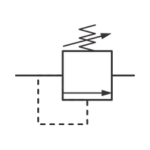
A Guide to Reading Schematics
Hydraulic systems are a critical part of modern machinery, powering everything from construction equipment to industrial machines. To effectively understand and troubleshoot hydraulic systems, one must be able to read and interpret hydraulic schematics. These schematics use a standardized set of symbols to represent various components and connections within the system.
The Importance of Hydraulic Symbols
Imagine trying to follow a map without a legend or key. You'd be lost and confused. Hydraulic symbols serve as the legend for hydraulic schematics. They provide a universal language that engineers, technicians, and maintenance personnel can use to communicate complex hydraulic system designs. Here's why understanding these symbols is crucial:
1. Efficient Troubleshooting
When a hydraulic system malfunctions, time is of the essence. Understanding hydraulic symbols allows technicians to quickly identify the problematic component or connection. This leads to faster diagnostics and reduced downtime.
2. Effective Design and Maintenance
Engineers use hydraulic schematics to design systems and plan maintenance schedules. Without a grasp of symbols, they can't accurately represent the system's components and connections on paper.
3. Safety
Hydraulic systems can operate at high pressures and pose safety risks. Knowing how to interpret hydraulic symbols ensures that technicians and operators can safely interact with and maintain these systems.
Now, let's dive into some of the most common hydraulic symbols you'll encounter in schematics:
Common Hydraulic Symbols
1. Reservoir
The reservoir symbol represents the hydraulic fluid reservoir or tank. It typically resembles a rectangle with one or two vertical lines connected to it, indicating the fluid inlet and outlet.

2. Hydraulic Pump
The hydraulic pump is responsible for pressurizing the fluid. Its symbol often resembles a circle with a triangle pointing inward to represent the pump's intake.

3. Hydraulic Motor
A hydraulic motor is used to convert hydraulic energy into mechanical energy. Its symbol looks like a circle with a triangle pointing outward, indicating the motor's output.

4. Directional Control Valve
Directional control valves manage the flow of hydraulic fluid in different directions. They are represented by rectangles with arrows inside, indicating the flow path.

5. Check Valve
A check valve ensures one-way flow of hydraulic fluid. Its symbol features an arrow inside a circle, indicating the direction of flow and a triangle pointing in the opposite direction to signify the valve's blocking function.

6. Pressure Relief Valve
Pressure relief valves protect the hydraulic system from overpressure. Their symbol often looks like a rectangle with an arrow pointing away from it, representing the relief of excess pressure.

7. Filter
Filters are used to remove contaminants from the hydraulic fluid. Their symbol is typically a square with diagonal lines inside, symbolizing filtration.

8. Cylinder
Hydraulic cylinders are used to convert fluid pressure into linear motion. They are represented by a rectangle with a diagonal line running through it, indicating the piston inside the cylinder.

9. Pressure Gauge
A pressure gauge measures the pressure within a hydraulic system. Its symbol looks like a circle with a needle pointing to a numerical value.

10. Flow Control Valve
Flow control valves regulate the flow rate of hydraulic fluid. They are often depicted as rectangles with arrows and a zigzag line, indicating flow rate control.
Reading Hydraulic Schematics Step by Step
Now that we've covered some common hydraulic symbols, let's walk through the process of reading a hydraulic schematic:
Step 1: Identify Key Components
Start by identifying the key components of the hydraulic system, such as the pump, reservoir, valves, cylinders, and motors. Locate these components in the schematic.
Step 2: Understand Flow Paths
Examine the directional control valves and their associated arrows to understand how fluid flows through the system. Pay attention to the arrows' direction and any labels indicating the valve's function.
Step 3: Check for Pressure Regulation
Identify pressure relief valves and pressure gauges to understand how pressure is regulated within the system. Pressure relief valves ensure that pressure does not exceed safe levels, and pressure gauges allow you to monitor the system's pressure.
Step 4: Trace Actuators
Follow the lines and symbols that represent hydraulic cylinders and motors to see how they are actuated by the fluid flow. Note any additional symbols that represent sensors or feedback devices.
Step 5: Consider Filtration and Cooling
Look for filter symbols to understand where contaminants are removed from the hydraulic fluid. Additionally, locate symbols that represent heat exchangers or cooling systems, as these are essential for temperature control.
Step 6: Check for Redundancy and Safety Features
Inspect the schematic for redundancy in critical components. For safety, make sure pressure relief valves are appropriately placed to prevent overpressure situations.
Step 7: Interpret Any Additional Symbols
Some hydraulic schematics may contain unique symbols or labels specific to the system. Consult any accompanying documentation to understand these symbols fully.
Conclusion
Hydraulic symbols are the keys to unlocking the secrets of hydraulic schematics. With a solid understanding of these symbols, you can confidently read and interpret hydraulic system designs, troubleshoot issues, and contribute to the efficient operation of hydraulic machinery. Whether you're an engineer, technician, or enthusiast, mastering hydraulic symbols is a valuable skill that will serve you well in the world of fluid power. So, the next time you encounter a hydraulic schematic, remember that it's a map waiting to be decoded, and you now have the tools to do just that.
For help with all your hydraulic requirements and talk to our experts, please contact VHS Hydraulic Components on: 0114 276 4430 / E: info@www.hydraulic-components.net or visit our website at: https://www.hydraulic-components.net.





 No Minimum Order
No Minimum Order















